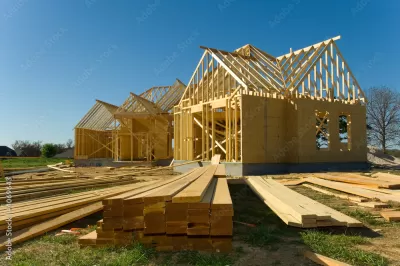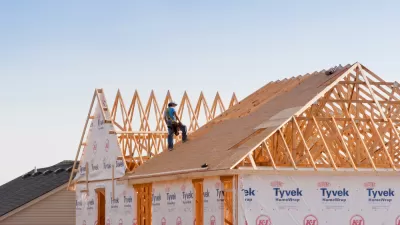U.S. homes are adding bedrooms while getting smaller, according to two seemingly contradictory articles published on the same day from different data sources earlier this month.

Contradictory conclusions about the direction of the new-build housing market circulated online on the same day this month.
On August 22, an article by Justin Fox for Bloomberg included the following data to support an article about the increasing number of bedrooms in newly constructed housing units.
Of the just over a million new single-family houses completed in the US last year, 490,000 had four or more bedrooms. That worked out to a 48% share, the highest since the US Census Bureau started keeping track in 1973—and more than double the percentage in 1973.
Another article, by Maggie Eastland for the Wall Street Journal [paywall], reported on generally shrinking footprints of new housing construction:
Since 2018, the average unit size for new housing starts has decreased 10% nationally to 2,420 square feet, according to Livabl by Zonda, a listing platform for new construction homes. Construction starts for new single-family homes declined in 2022. But starts for homes with fewer than three bedrooms increased 9.5% over the same period, according to a Zillow report.
The stories don’t totally reach opposite conclusions, however. Fox’s coverage acknowledge’s that the increase in the number of bedrooms doesn’t necessarily mean a commensurate increase in square footage:
While the median floor area of new single-family houses rose slightly in 2022, to 2,299 square feet, it’s still below pre-pandemic levels, and quarterly statistics on housing starts indicate that it will fall in 2023. But the uses to which that space is put are changing.
Further complicating any simple interpretation of the two stories are the explanations behind each of the trends reported by these two articles. Both assumptions seem reasonable: Americans want more bedrooms to facilitate working from home, according to the story about homes adding bedrooms, and less square footage is intended to lower the cost of housing, according to the story about homes decreasing in square footage.
FULL STORY: Never Mind Shrinking Households, Builders Are Adding Bedrooms

Planetizen Federal Action Tracker
A weekly monitor of how Trump’s orders and actions are impacting planners and planning in America.

Congressman Proposes Bill to Rename DC Metro “Trump Train”
The Make Autorail Great Again Act would withhold federal funding to the system until the Washington Metropolitan Area Transit Authority (WMATA), rebrands as the Washington Metropolitan Authority for Greater Access (WMAGA).

The Simple Legislative Tool Transforming Vacant Downtowns
In California, Michigan and Georgia, an easy win is bringing dollars — and delight — back to city centers.

The States Losing Rural Delivery Rooms at an Alarming Pace
In some states, as few as 9% of rural hospitals still deliver babies. As a result, rising pre-term births, no adequate pre-term care and harrowing close calls are a growing reality.

The Small South Asian Republic Going all in on EVs
Thanks to one simple policy change less than five years ago, 65% of new cars in this Himalayan country are now electric.

DC Backpedals on Bike Lane Protection, Swaps Barriers for Paint
Citing aesthetic concerns, the city is removing the concrete barriers and flexposts that once separated Arizona Avenue cyclists from motor vehicles.
Urban Design for Planners 1: Software Tools
This six-course series explores essential urban design concepts using open source software and equips planners with the tools they need to participate fully in the urban design process.
Planning for Universal Design
Learn the tools for implementing Universal Design in planning regulations.
Smith Gee Studio
City of Charlotte
City of Camden Redevelopment Agency
City of Astoria
Transportation Research & Education Center (TREC) at Portland State University
US High Speed Rail Association
City of Camden Redevelopment Agency
Municipality of Princeton (NJ)




























